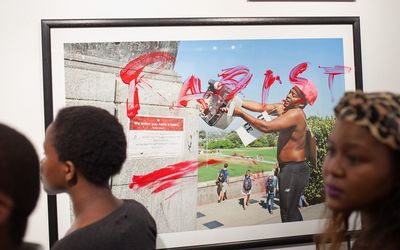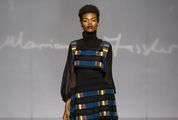HALF ART: Art is not a blank canvas for protesters’ outrage
by Chris Thurman,
2016-03-18 06:18:29.0
IT IS time for South Africans to stop defacing works of art. I am aware that in saying this, I run the risk of sounding like a grumpy old reactionary. It’s a terribly unpost-postmodern, un-anticolonial stance to adopt. But, there you go.
In 2012, when red crosses and black splotches of paint covered Brett Murray’s controversial depiction of Jacob Zuma in "The Spear", there was a frisson of excitement. Shock! Horror! Delight! The defacement, like the crowds gathered in protest outside the Goodman Gallery and the threats uttered by politicians, at least signalled that people were paying attention to art: for better or worse, the episode seemed to confirm — works of art matter.
Fast-forward a couple of years and the Tokolos Stencils crew, known in particular for its graffiti reminders of the Marikana massacre, set their sights on Michael Elion’s "Perceiving Freedom". The sculpture — a giant pair of Ray Ban sunglasses looking from the Sea Point promenade across the sea to Robben Island — was widely criticised for its crass conflation of struggle history and consumerism, and it seemed that the consensus was, "he asked for it".
Chumani Maxwele throwing human faeces at that statue of Cecil John Rhodes at the University of Cape Town (UCT) was not, properly, an act of defacement; the poo was washed away easily enough. And when it was subsequently damaged, the ugly statue of an ugly man was no longer viewed as a work of art — it had now become a symbol of a much broader phenomenon.
It has been almost a year since the statue was removed, and we are still no closer to a policy, or even a formalised public consultation, over what to do with dozens of similarly problematic statues across the country.
Last month, a different #RhodesMustFall activation led to the painting-burning debacle. Readers of this column will know that, while I don’t condone the destruction of any artwork, the canvas pyres at UCT formed part of an irresolvably complex historical moment in the higher education sector in the country and must be seen within the context of other literal and figurative fires on our campuses.
And then, in a further twist, UCT’s Trans Collective disrupted the disrupters-in-chief: at the opening of an exhibition curated to tell the "evolving story" of the #RhodesMustFall movement, protesters entered the gallery and defaced photographs and other documentary works.
Their message was clear: RMF pays lip service to "intersectionality" but is in fact guilty of "faux inclusivity" when it comes to those who identify as both black and "trans" or "queer".
A photograph of Maxwele even had the word "rapist" daubed across it.
This gendered critique is not without substance. There has been a disturbing strand of hypermasculinity in many instances of student activism in the past year or so, even though women have been prominent as leaders of RMF or #FeesMustFall.
For the Trans Collective, however, it goes further: "black women", they argue, are "complicit" in the erasure of trans or queer people from the profile of the movement.
RMF, they claim, reinforces heteronormativity and, more generally, fails to challenge the reigning patriarchy.
Now, there are a lot of long words to digest here. So perhaps, you may be thinking, there is a case for simple, direct expressions of opposition: the insertion of naked "queer" bodies into the gallery space followed by the defacing of images that are deemed to offer only a glancing acknowledgement of those bodies and the identities they represent.
It is a case of spectacle trumped by spectacle — RMF, detractors might cynically affirm, has been hoist with its own petard.
But where does that leave us? Does the Trans Collective have the final say? Or will they be subjected, in turn, to the politics of disruption and defacement when next they embark on a project — a campaign, an event, an exhibition?
Let’s call it quits, people. We are at risk of turning the gallery space and the city street alike into stages for elaborate tit-for-tat pageants in which dissent means shouting down those with whom you disagree — and perhaps physically strong-arming them.
If I were the type to commit the slippery slope fallacy, I would be worried about where that may lead.

UCT’s Trans Collective used their naked bodies and defaced photographs at an exhibition after they had taken issue with the#RhodesMustFall movement. Picture: GROUNDUP/ ASHRAF HENDRICKS
IT IS time for South Africans to stop defacing works of art. I am aware that in saying this, I run the risk of sounding like a grumpy old reactionary. It’s a terribly unpost-postmodern, un-anticolonial stance to adopt. But, there you go.
In 2012, when red crosses and black splotches of paint covered Brett Murray’s controversial depiction of Jacob Zuma in "The Spear", there was a frisson of excitement. Shock! Horror! Delight! The defacement, like the crowds gathered in protest outside the Goodman Gallery and the threats uttered by politicians, at least signalled that people were paying attention to art: for better or worse, the episode seemed to confirm — works of art matter.
Fast-forward a couple of years and the Tokolos Stencils crew, known in particular for its graffiti reminders of the Marikana massacre, set their sights on Michael Elion’s "Perceiving Freedom". The sculpture — a giant pair of Ray Ban sunglasses looking from the Sea Point promenade across the sea to Robben Island — was widely criticised for its crass conflation of struggle history and consumerism, and it seemed that the consensus was, "he asked for it".
Chumani Maxwele throwing human faeces at that statue of Cecil John Rhodes at the University of Cape Town (UCT) was not, properly, an act of defacement; the poo was washed away easily enough. And when it was subsequently damaged, the ugly statue of an ugly man was no longer viewed as a work of art — it had now become a symbol of a much broader phenomenon.
It has been almost a year since the statue was removed, and we are still no closer to a policy, or even a formalised public consultation, over what to do with dozens of similarly problematic statues across the country.
Last month, a different #RhodesMustFall activation led to the painting-burning debacle. Readers of this column will know that, while I don’t condone the destruction of any artwork, the canvas pyres at UCT formed part of an irresolvably complex historical moment in the higher education sector in the country and must be seen within the context of other literal and figurative fires on our campuses.
And then, in a further twist, UCT’s Trans Collective disrupted the disrupters-in-chief: at the opening of an exhibition curated to tell the "evolving story" of the #RhodesMustFall movement, protesters entered the gallery and defaced photographs and other documentary works.
Their message was clear: RMF pays lip service to "intersectionality" but is in fact guilty of "faux inclusivity" when it comes to those who identify as both black and "trans" or "queer".
A photograph of Maxwele even had the word "rapist" daubed across it.
This gendered critique is not without substance. There has been a disturbing strand of hypermasculinity in many instances of student activism in the past year or so, even though women have been prominent as leaders of RMF or #FeesMustFall.
For the Trans Collective, however, it goes further: "black women", they argue, are "complicit" in the erasure of trans or queer people from the profile of the movement.
RMF, they claim, reinforces heteronormativity and, more generally, fails to challenge the reigning patriarchy.
Now, there are a lot of long words to digest here. So perhaps, you may be thinking, there is a case for simple, direct expressions of opposition: the insertion of naked "queer" bodies into the gallery space followed by the defacing of images that are deemed to offer only a glancing acknowledgement of those bodies and the identities they represent.
It is a case of spectacle trumped by spectacle — RMF, detractors might cynically affirm, has been hoist with its own petard.
But where does that leave us? Does the Trans Collective have the final say? Or will they be subjected, in turn, to the politics of disruption and defacement when next they embark on a project — a campaign, an event, an exhibition?
Let’s call it quits, people. We are at risk of turning the gallery space and the city street alike into stages for elaborate tit-for-tat pageants in which dissent means shouting down those with whom you disagree — and perhaps physically strong-arming them.
If I were the type to commit the slippery slope fallacy, I would be worried about where that may lead.




















Change: 1.19%
Change: 1.36%
Change: 2.19%
Change: 1.49%
Change: -0.77%
Data supplied by Profile Data
Change: -0.19%
Change: 0.69%
Change: 1.19%
Change: 0.00%
Change: 0.44%
Data supplied by Profile Data
Change: 0.62%
Change: 0.61%
Change: 0.23%
Change: 0.52%
Change: 0.12%
Data supplied by Profile Data
Change: -0.21%
Change: -1.22%
Change: -0.69%
Change: -0.51%
Change: 0.07%
Data supplied by Profile Data